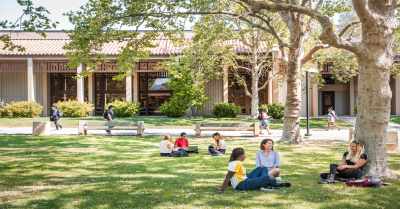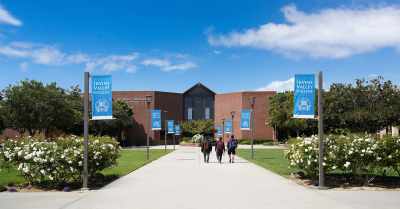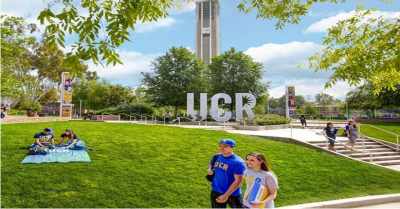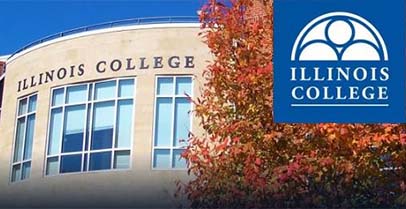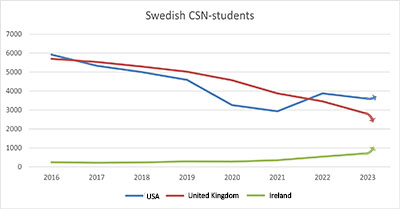Study in USA
More than one million international students studied in the US last year. Here we look at why and how you can study in USA and answer all common questions about studying there.
Short term options to study in the US
How much does it cost to study in the US?
Insurance for studying in the US
Working as a student in the US
Can you help me to study in the US?
For this article we invited the American student Michaela Lord as a guest writer. About half the text below is written by her based on her own experience. We have then added some additional facts and topics to give a complete guide for international students.
So, are you interested in learning in the world’s most diverse country? Are you curious about the American educational system? While the United States is popular for its entertainment, culture and overall global persona, it is an ideal place for a foreigner to go to if they want to study abroad. Learn more here:

Why Study in the US?
Historical background
The United States is arguably the place to go to if you want to study abroad and go to the Americas. While its power standing has been questioned numerous times in the past decade, it is known as the land of the free. Built on a revolution against Great Britain for independence in 1776, the United States has grown considerably for a young country, despite its history of being in wars. Having their own Civil War and then being players in the two World Wars, the United States earned its reputation from international involvement in these tragedies. It was post World War II when the country was able to experience a boom, and earned its title as a superpower.
Social development
The United States has its own unique culture and depending on the region you go to, one can have varying experiences, and their reactions will depend on the given area. In general, the United States are divided into the following regions: Northeast, Southeast, Midwest, Mid-Atlantic, West and Southwest. When studying, it is smart to research the area you will be living in. Due to the country being the fourth largest in the world, the climate is drastically different, and one can experience different climates by going a few states away. With different temperate zones, this also leads to various landscapes to view while studying abroad, making for interesting vacation ideas.
Cultural and geographical diversity
The United States has been experiencing many different movements and political changes. One of the best qualities about the US is the right to freedom of speech and assembly. Because of the ability to protest, the Civil Rights Movement and the Women’s Movement, along with LGBT rights, have successfully passed through their highest law-making body, Congress. Due to this, the United States is a popular destination for immigrants, especially those who were exiled by their communities due to politics, religion or even race/ethnicity.
Overall, the United States is a melting pot of different waves of immigration and migration, making it an ideal place for the international student. In cities like Los Angeles, Miami, New York City and Boston, the immigrant population is high enough that one can feel at home. Depending on your interests, you might find yourself in a large city, small city, the country or even in a college town (we’ll explain this later). You could be in an area that is dense with forests, hills, deserts, lakes, etc.
Science and technology advances
Since World War Ⅱ, the US has become the global leader in Science and Technology. It has attracted top talented scholars and scientists from all over the world to realize their scientific pursuit. Since 1950, approximately half of the Nobel Prizes laureates have been from the US. Today it is the home of technology giants like Apple, Microsoft, Google, Facebook, Intel among many other leading companies in the industry.
Economic power
Being the world’s largest economy, the US is the driving force for industry development in computers, pharmaceuticals, aerospace, military equipment, etc. US dollars is a global currency, accepted for trade throughout the world. Nearly ¼ of the world’s 500 largest companies have their headquarters in the US and the largest stock exchanges and transactions take place every day in Nasdaq and New York Stock Exchange.
All the above truly makes the US a land full of opportunities. On top of that, it is home to many of the best universities in the world. Below you can read more about the American Education system.

The US Educational System
Primary and Secondary School
To explain the US educational system, one must understand the way of the land. The United States makes it mandatory for students to go to school for 12 years of primary education (excluding kindergarten). Students are usually 18 years old when they graduate from high school. Those who drop out of high school can still earn their diploma by passing the GED-test. However, if you did not finish high school I would recommend taking a look at Seattle Central College's fantastic High School Completion Plus program that gives you a High School Diploma from Washington State AND an Associate Degree in only two years!
If you are applying for college in the states, make sure that you have the equivalent level of years met for requirements. In the US, there are the federal or general laws for the entire nation, and then there are state laws which differ depending on where you study. For college, the US allows the states to make the regulations, so check the school’s admission requirement for international students to make sure you qualify to apply.
Community College (Junior College)
The United States has two types of higher level education. There are community colleges (two-year colleges), and there are universities (four-year colleges). At a community college, people can obtain an Associate’s Degree, which is roughly 60 credits. It takes a full-time college student two years to obtain this degree, and it is much cheaper than studying at a university. At some community colleges, students can earn a bachelor degree in four years, which is also provided by all universities. Students with an Associate Degree can transfer directly into the third year of a university program with their credits being rolled into the bachelor degree, which is more specific and has other requirements. Read more about Community Colleges in the US for international students.
University
Universities, on the other hand, are larger and considered the “traditional” American college. Universities usually have research groups, various options for activities and an array of options to “major” and “minor” in. For an undergraduate (a student who is obtaining a Bachelor Degree, also known as a 4 year degree), a major is the subject matter they are obtaining the degree in. For example, I happen to be an American student who majored in psychology. This means that I took most of my classes in psychology. Now, I also minored in sociology, which means that I took multiple classes in this subject, but I did not concentrate on it. Depending on which university you attend and what you want to do, you can major, minor and even double major and minor in hundreds of subjects.
State universities and "University of" institutions represent two prominent pillars within the U.S. higher education system, both offering distinct experiences tailored to diverse student needs. State universities, such as Arizona State University and Colorado State University, are often recognized for their broad access, diverse program offerings, and relatively lower tuition costs for in-state residents. They typically have large student populations and pride themselves on creating an inclusive environment that reflects the demographic diversity of their state. These institutions are particularly appealing to students seeking a comprehensive educational experience without breaking the bank, providing a solid foundation in both academics and practical skills across a wide range of disciplines.
On the other hand, "University of" institutions, like the University of California, Santa Barbara, and the University of Pennsylvania, frequently carry a prestige associated with academic rigor, extensive research opportunities, and strong alumni networks. Though they may also be public, as in the UC system, their selective nature often leads to higher tuition rates and more competitive admissions processes, especially for out-of-state and international students. "University of" schools are ideal for students who are aiming for a highly specialized education or research opportunities in specific fields, offering an environment where cutting-edge innovation and academic excellence are the norms. Despite the differences, both types of institutions strive to provide quality education, preparing students for successful careers and meaningful contributions to society.
At University of California Riverside the costs are a bit lower and you can experience 1-2 semesters as a visiting student on undergraduate or postgraduate level.
Majors, Minors - choose subjects of your interest
When you are majoring/minoring in a subject, you are trying to obtain a career related to this field; it is essential to know what you want to do. While you can change your major (I did myself. I was originally a political science major), it can be difficult to transfer old credits into your new program. Sometimes, people will have to stay in college longer due to the change, but don’t worry! Many go to school all over again, thanks to changing their mind. To me, this is the beauty of the American school system. Instead of being forced into a program, you can express your own interests and decide on subjects that you could want to be in for the future. For international students subjects such as business, international relations, it, tourism and even the social sciences are high-interest points thanks to their ability to convert easily back in one’s home country.
Highest ranking universities
There are many different university rankings. Most of them are made in the United States, which may explain that so many US universities are highly ranked. However, there is no doube that many of the world's leading universities are American. Rankings change from year to year, but the schools that usually rank in the top thirty in the United States are:
- California Institute of Technology
- Stanford University
- Massachusetts Institute of Technology
- Princeton University
- Harvard University
- Yale University
- University of Chicago
- University of Pennsylvania
- Johns Hopkins University
- University of California, Berkeley
- Columbia University
- University of California, Los Angeles
- Cornell University
- Duke University
- University of Michigan-Ann Arbor
- Northwestern University
- University of Washington
- Carnegie Mellon University
- New York University
- University of California, San Diego
- Georgia Institute of Technology
- University of Texas at Austin
- University of Illinois at Urbana-Champaign
- University of Wisconsin-Madison
- Washington University in St Louis
- Brown University
- University of North Carolina at Chapel Hill
- University of California, Davis
- University of California, Santa Barbara
- Boston University
Here you can find a list of all the most high ranking and popular schools and universities in the US.
We have partners that can help you apply to many universities in the US including Ivy-league and the highest-ranking universities. Fill out an info request to get help to choose and apply to a suitable college or university in the US.
Short term options to study in the US
Studying a full degree in the USA means a higher threshold to be admitted, a several years commitment, and not least a big financial investment. As an international student, there are also some more affordable short term options to realize the dream of studying in the USA.
English language school
If your English is not good enough, the quickest way to improve is to study at a language school in an English speaking country like the USA. You will learn the language both in school and in daily life where you get to practice it in real-life scenarios. A full-time English language course is about 20-30 hours of study weekly. There you can train the business language for professional purposes, prepare yourself for the university/college entrance, and get assimilated into the American culture.
Study abroad semesters
You can take 1-2 study abroad semesters at American universities, to try different courses and explore your interest. Usually, you choose freely among available courses and take 4 courses per semester. If you are already enrolled in a university in your home country the credit you have earned in the US can often be counted towards your degree in your home university. And the same is true if you decide that you want to continue to study on a degree program in the USA. Some universities only take exchange students that are enrolled in another university while others have programs that are open for anyone who has graduated from high school.
We can help you with attractive study abroad programs at high ranking University of California Santa Barbara.
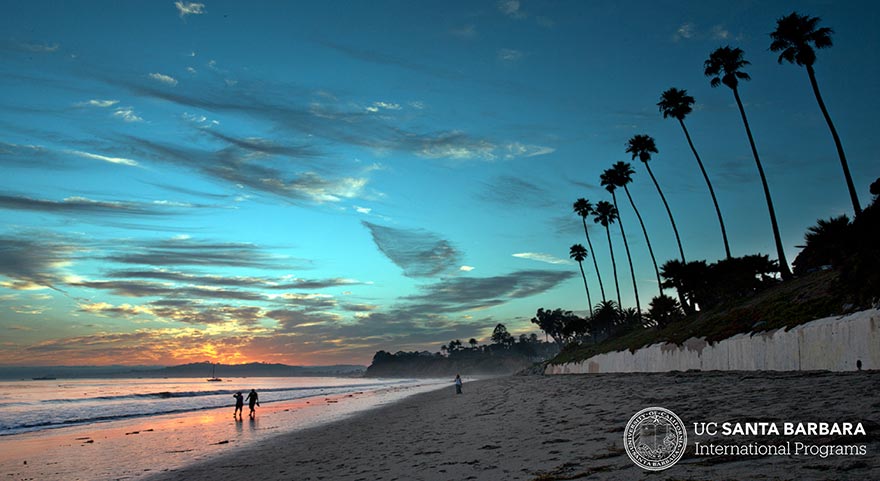
When and how to apply?
School calendar
The majority of American colleges/universities have a two-semester year, and the semesters are usually 16 weeks long. The school year starts with the fall semester which begins in late August or early September and ends in December. From here, college students have a few weeks off for a break, and then they continue their education in the “spring semester” This lasts from early January to the end of April-early May. Unless you just du an exchange semester, it is better to start your studies in the US in the fall, so you follow the school year.
Some schools, primarily smaller colleges, have a quarter system where you can take up to four semesters (quarters) per year. Each quarter lasts 10-12 weeks so usually students only take three quarters per year and then have a break for one quarter.
When to apply?
So when should you apply? In the United States there is no central admission authority so each school set their own deadlines. The top universities usually have their application deadline already in November or December for courses starting in the fall and in March or April for programs starting in the spring. Other universities with good rankings usually have deadlines in March or April for the fall semester and July or August for the spring semester. Lower ranking universities and smaller schools such as Community Colleges often don’t close application window for the fall semester until June or July and October or November for the spring semester. However, as an international student you should keep in mind that you will need a couple of months to apply, arrange a visa etc so don’t apply too late! There is a lot of documents to prepare as you can see below.
Admission requirements
Go to the schools website and look up the admission requirements to find out which documents you will need to fill in and prepare for the application. You will need to show that you have enough money for your studies and that your English level is good enough. American universities prefer the TOEFL-exam to prove your English level but most of them also accept the IELTS-exam.
If you apply for a degree program tests like SAT or ACT might be required for undergraduate and GRE or GMAT are common requirements for graduate programs. Apart from standardized tests, personal statements, recommendation letters, official transcripts, and highest degree certificates are also common requirements. Some universities interview applicants. Read more about how to apply to universities abroad.
We and our partners can help you to choose a school and apply to many universities, colleges and language schools in USA. Fill out an info request to get help.
How much does it cost to study in the US?
Tuition
This is a sore subject to many Americans, thanks to the high costs to obtain a college education. In almost all states, it is more cost efficient to attend community college and then transfer to a university. For example, when I attended community college first for my Associate’s in arts, I was paying roughly $144 per credit hour. The majority of classes you take are three credit hours, so I was paying $432 per class. When I continued my studies at the University of Louisville, I paid $444 PER credit hour. More than three times the price I paid at Community College.
While many countries charge different tuition fees for domestic and international students, pricing in US universities also differs between in-state and out-of-state students. To give an example, I attended Louisville where I am from for two years, and I paid $16,000 per year for tuition. When my friend transferred to an out of state college in Indiana, she was paying roughly $40,000. The price for out-of-state students, including international students, can be two or three times as expensive as for in-state students.
Now, I promise I am not trying to induce a heart attack. This is what many citizens have happen to them. However, many colleges in the states are tuition friendly and have fantastic study abroad programs. In fact, areas that are known to have higher levels of immigration are also well known to give great tuition rates for students! The United States does not give out student loans to students who are not actual residents of the country, but you might be eligible for those from your home country. However, you can receive grants and scholarships from your college. The best part? If you receive grants and scholarships from your school you don’t owe anyone any money back from them! Look into your chosen school’s program, and know what you’d be getting yourself into before you decide. Read more about scholarships in the US below.
Living costs
The living cost varies depending on location and your accommodation. In general, the coastal areas are more expensive than the inland. Big cities like New York, Boston, LA, Chicago have higher living costs particularly in housing. Renting a studio in such cities can be very costly, up to $ 2000-3000 monthly, while you can get a one room apartment in the Midwest for only about $ 500/month.
On-campus dormitory or sharing an apartment off campus is usually the most economic accommodation if you don't mind having roommates and a shared bathroom. The average cost for room and board (i.e. housing and food) for US college students is about $9000-$10000 /year.
The price for utilities, Internet, phone bill and public transportation is not majorly different from other developed countries. Gasoline and second hand cars on the other hand are much cheaper but don’t forget to get a driving insurance! Cars are heavily relied on in American life, which is particularly true if you don't live in a metropolitan area where there is a better public transportation network. There are plenty of choices for clothes, groceries and meals. You can always find a way to cut the cost but you can also spend a lot depending on your lifestyle.
Then there are also costs for textbooks, and insurance etc. that need to be taken into account. All in all we would recommend a budget of $1500/month for living costs in the US. If you live in a non expensive area you can get by on less, but in the big cities it is easy to spend more.
Read more about costs for studying abroad.
Scholarships to study in USA

USA has some of the highest tuition fees in the world. It is status to have high tuition fees in the US, but that also means that schools have money to give back to students as scholarship. Therefore few American students pay the list price, especially on the more expensive schools. Some scholarships are only available for American citizens but most universities offer some scholarships for international students too.
Academic scholarships are the most common. They give students that maintain good grades a scholarship discount of 5-30% of the tuition fee. Full scholarships are very rare on undergraduate level unless you are a very talented athlete or have other equivalent talents. On graduate level it is easier for talented scholars to get big scholarships, often in return for services to the school for example being a teacher assistant or research assistant.
Scholarships and discounts from our partner schools
| $8,000 DreamStudies Impact Scholarship at CSU - Colorado State University (deadline 2024-12-02) |
| $23,000 USD/Year Scholarship at Illinois College (deadline 2030-01-01) |
| Scholarships for international students at ASU - Arizona State University (deadline 2024-07-31) |
| International Scholarship - Bethany Lutheran College (deadline 2030-12-31) |
| 1 scholarship for language courses in Santa Monica - CEL College of English Language (deadline 2024-05-24) |
| Partial Scholarships for Dream Studies applicants - University of California, Riverside (deadline 2024-06-01) |
| Competitive Scholarships for Study in NYC - St. Francis College (deadline 2024-08-01) |
| $500 discount on Los Angeles City College (deadline 2026-08-30) |
| Scholarships at Laney College (deadline 2024-05-25) |
| Scholarships at Berkeley City College (deadline 2024-05-25) |
| Sports and scholarships at Peninsula College (deadline 2025-03-10) |
You can also apply for DreamStudies’ scholarship and read more in our Scholarship guide for studying abroad.
Insurance for studying in the US
It is very important to have a good insurance when you study in the US. It can be extremely costly if you get sick or end up in a legal situation without an insurance. Many schools demand that you show an insurance policy the first day at school. We recommend Dr Walter's Protrip World insurance which provides good coverage for a good price. It is available for all nationalities.
You will need a separate insurance if you plan on driving in the US. Read more about study abroad insurances.
Student visa
You will need an F-1 student visa to study in the US (unless you only go for a short language course with few hours per week). Once you are enrolled in a US school, they will send you an I-20 document that you need for the visa application. Read more in our guide about student visa to the US.
Working as a student in the US
You can work as a student in the US, but the requirements are strict. You need to have your student visa and get a social security card. Then you will be allowed to work up to 20 hours per week on-campus. These types of employment opportunities are usually flexible for the student, but if you study at a smaller school it might be hard to find jobs on campus. You can work full-time during the vacations if you will be staying at the university for the next semester
To work off-campus, you must either work at a location affiliated with your school or do work as an integral part of your academic program, for example, a paid internship. A student who experiences Severe Economic Hardship might also be allowed to work off-campus if they cannot find a job on-campus. Check with the international office at your school to make sure that your work is allowed.
The final option to work as a student in the US is with optional practical training (OPT). To do this, you will need approval from the U.S. Citizenship and Immigration Service. To apply, you must have studied at least nine months in the US and it will be granted at the earliest 12 months after you started your studies. Your OPT-work must be directly related to your academic major. OPT allows you to work full time in the US for 12 months after you have finished your studies. You can also work half time on OPT while you study but then each two months you work half time will shorten your work period after graduation by one month. Read more about OPT on Wikipedia.
Student housing
Student housing is stereotyped pretty accurately in the states. In universities and colleges (not community colleges), most beginning students live in dorms. These differ in quality and style for each dorm. The majority require students to have a roommate or even multiple roommates. Some colleges allow for students to have their private dorm room, but they are not as frequent. College dorms are mixed gender, but your roommate will be the same gender as you. Many times, the bathrooms are either shared between the roommates or an entire floor. As the college student ages, they can move to apartments associated with the college and have more freedom.
Our partner Uhomes offers student housing close to most colleges and universities in the US. Fill out their Student Apartment Application Form to get free help to find accommodation close to your school.
Student Life

While the American college life sounds like a death sentence thanks to the price, it is a great experience socially. In the states, Greek life is a huge part of campus culture. For males, this is a fraternity, and for women, this is a sorority. This showcases community, unity and being a part of an organization. Many colleges are also well known for their athletics. If you are an international student, you can be involved by attending games on campus and even being a part of the team, whether it is the college level or intermural for fun. Colleges are often based in towns that are populated by the students, making the experience even more fun with a plethora of things to do!
Can you help me to study in USA?
Yes, we have helped students study in USA since 2002. We and our partners can help you to choose and apply to selected colleges, universities and language schools in USA. However, please note that we cannot help you fund your course so you will need savings to cover tuition fee and living costs. Fill out our request form and we will send you more information about studying in USA.





